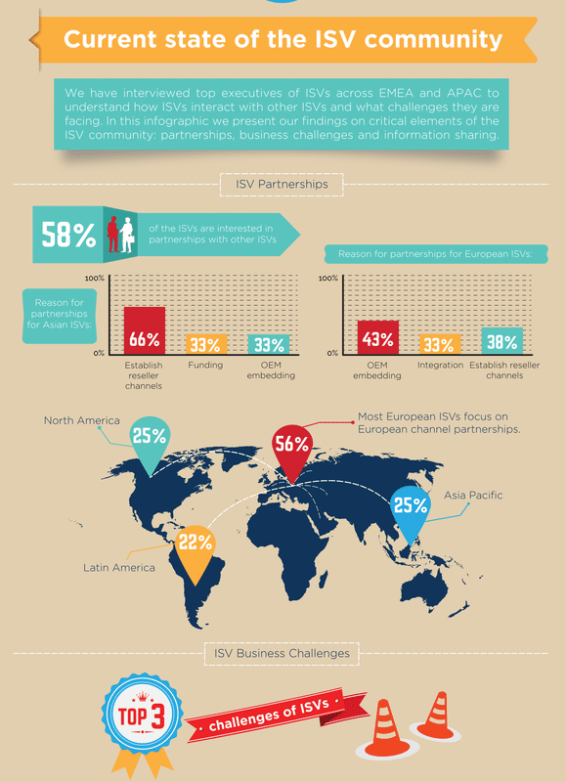What is an OEM partnership and why is it important for an ISV? Well, first and foremost, the term OEM is being used to mean a lot of things to a lot of different people these days. Yes, I know it’s supposed to mean “original equipment manufacturer,” but let’s face it: the more practical use cases tend to describe an OEM partnership as being one where a software publisher takes the features of another and embeds them into their solution. So for example, I develop and sell my own CRM system, and I want data analytics to be part of my product. Instead of developing those features myself, I take a data analytics software and “merge” it with my CRM so that presto-chango and voilà, my product has those functionalities. Of course, the end-user doesn’t know that those features come from another provider, as the white-labeling element makes it appear just a natural part of my product.
The benefit for the provider and the embedder is obvious: the provider benefits from an increase in sales as a kick-back is given per license sold (and sometimes, additional fees are also required); the embedder benefits by product enhancements which should help increase sales, provide access to new market segments, and make the overall user experience better. For ISVs, OEM partnerships can be the greatest invention since sliced bread. Here’s why:
Sell more product without selling it yourself
Since OEM partnerships are a win-win scenario for both ISVs involved, the provider of the embedded software is able to sell more product without directly selling it to the end-user himself. That means the time spent onboarding a new OEM partner could result in ten-fold the actual sales volume you’d get elsewhere. Since OEM relationships are not meant to be short-term or one-off deals, this can mean an important recurring revenue stream for the provider.
OEM marketing means a highly targeted outreach
Generating OEM leads requires thought leadership. Being a leader in your domain is a prerequisite for any OEM offer, which means establishing credibility for your brand is a must. Of course, this takes time, great content, and a solid outreach strategy (on and offline). OEM marketing is not without its challenges, but any good B2B marketer loves a challenge! And from our experience executing these types of outreach programs, product decision-makers are keen to learn about OEM offers since they know the right one can enhance their solutions with minimal work. What’s sure is that OEM marketers will never get bored since there’s always work to do!
Marketing a product that’s benefited from an OEM partnership makes life easy
On the flip side, the ISV who has embedded features into its solution can benefit from a radical change to its value proposition. With a faster time-to-market than if those same features were developed in-house, the ISV can quickly highlight those enhancements in marketing messages. This quick access to industry-leading technology not only helps reduce product development costs, but it can vastly improve key selling points when targeting end-users, helping the ISV to reduce the sales cycle and sell more product. And let’s not forget that some OEMs help their partners with their go-to-market strategy development, and may even provide backing for marketing initiatives as well. Having the right support for ISV marketing will help get the word out that the solution is “new and improved” and can help generate interest in new buyer personas that may not have evaluated the product otherwise.
Conclusion
When considering establishing an OEM partnership, it’s important for both sides to take the time needed to fully evaluate the advantages and inconveniences. Not all OEM partnerships are alike, and it’s important that the ISV knows what they are getting into before they sign a contract; communicating the desired outcome and formulating the exact need that is to be fulfilled will help the ISV evaluate whether the OEM offer is right for them. The OEM provider also needs to be sure that they are targeting the right ISV who will help ensure the ROI of the investment. If the ISV is not capable of reaching the sales levels expected (which could happen for reasons unrelated to the deal), the partnership will be doomed to fail. What’s sure is that ISV-to-ISV OEM relationships are on the rise, and will only continue as up-and-coming players/innovators release new solutions onto the market. Be on the lookout for emerging markets — the software boom is far from over yet!

Here are the insights of the survey we conducted among ISVs in EMEA and Asia-Pacific.
We have interviewed top executives of ISVs across EMEA and APAC to understand how ISVs interact with other ISVs and what challenges they are facing. In this infographic we present our findings on critical elements of the ISV community: partnerships, business challenges and information sharing.



